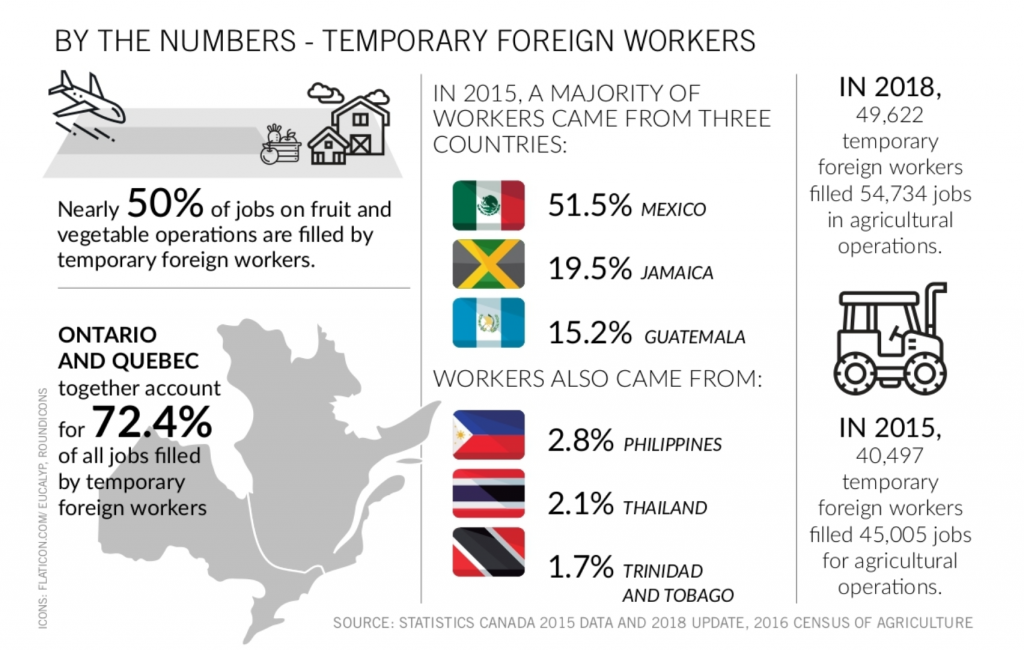
News
Labour
About 14 per cent less agricultural workers arrived in Canada than in 2019
Despite the pandemic, Canada still managed to welcome the majority of its expected workers.
May 12, 2020 By Stephanie Gordon
Despite COVID-19 delays in 2020, Canada welcomed nearly 22,000 agricultural workers in Canada by the end of April, compared with about 25,500 at the end of April in 2019. These numbers reflect a 14 per cent decrease from 2019 to 2020, highlighting the impact the pandemic has had in Canada.
On May 12, Marie-Claude Bibeau, federal minsiter of agriculture, published a statement on temporary foreign workers (TFWs) highlighting all the steps the Canadian government took to ensure the safety and reliability of the agriculture sector workforce.
“When COVID struck, we immediately got to work, with the top three countries of origin for foreign primary agricultural and food production workers: Mexico, Jamaica and Guatemala,” Minister Bibeau’s statement began. “COVID struck at the busiest time for many farmers. April is the month that sees the most number of agricultural workers arrive.”
Despite the pandemic, Canada still managed to welcome the majority of its expected workers. Canada welcomed 11,000 workers to Canada in April this year, compared to about 13,000, in April last year.
Minister Bibeau explained that all the federal departments involved in the Temporary Foreign Worker program (TFWP) worked together to simplify processes and facilitate the safe entry of incoming workers, including priority processing of applications, highlighting that work permit applicants can continue working with the same employer while they have an extension application being processed, and the measures announced today to fast-track approval for workers in non-SAWP (Seasonal Agricultural Worker Program) streams to change jobs or employers.
In British Columbia, the province went a step further and housed all the seasonal workers arriving to work on farms in government-managed accommodations for the duration of the mandatory 14-day self-isolation period. The province also funded hotel and food-service costs during the 14-day self-isolation period.
To increase flexibility of the TFWP, the federal government increased the maximum duration of employment under Labour Market Impact Assessments (LMIAs) from one to two years for employers of workers in the low-wage stream and removed the minimum recruitment requirements for the next six months, for workers in agriculture and food processing.
Significance to the sector
In 2018, according to Statistics Canada, there were nearly 55,000 jobs filled by temporary foreign workers in Canada’s agriculture industry and these accounted for 20 per cent of total employment in the primary agriculture sector. Although, temporary foreign workers in 2018 came from nearly 100 countries, the majority came from Mexico (51 per cent); Guatemala (20 per cent) and Jamaica (18 per cent).
The horticulture sector depends significantly on TFWs, and 84.9 per cent of the jobs filled by TFWs were on 2,393 horticulture farms. According to Statistics Canada, horticulture farms include vegetable and melon, fruit and tree nut and greenhouse, nursery and floriculture operations. These horticulture operations represented $8.4 billion in farm cash receipts in 2018, accounting for 13.5 per cent of the total farm cash receipts in the Canadian agricultural sector.
Despite significant effort on the federal government’s part to bring in temporary foreign workers, some fruit and vegetable producers are still facing labour shortages. Most notably, New Brunswick producers who recently were alerted that their province would be enforcing its own provincial ban on any new incoming temporary foreign workers.

Statistics Canada’s 2016 Cenus of Agriculture provided a closer look at where temporary foreign workers were making the most impact. Eastern Canada and the horticulture sector accounted for most agricultural jobs.
Support for agriculture industry
Within the minister’s statement, several other supports announced by the Canadian government in recent weeks were also emphasized.
Additional support for the Canadian agriculture sector include:
- $50 million to help farmers and agri-food businesses to cover the costs of safely welcoming temporary foreign workers in compliance with the Quarantine Act.
- An announcement that $3 billion would be put in place to support wage top-ups for essential services – which includes workers across the food supply chain.
- The “Step up to the Plate – Help Feed Canadians” job portal, which is helping to match Canadians with jobs in the agri-food sector. This is coupled with temporary changes to the Canada Summer Jobs program that will offer more help to essential services including the agri-food supply chain.
- $77.5 million Emergency Processor Fund to help processors with safety retrofits and personal protective equipment costs.
“We recognize our producers and processors are important engines of the economies in their communities and our whole country. We will be there every step of the way to support their safety, their stability and their growth,” Minister Bibeau concluded the statement.
Print this page